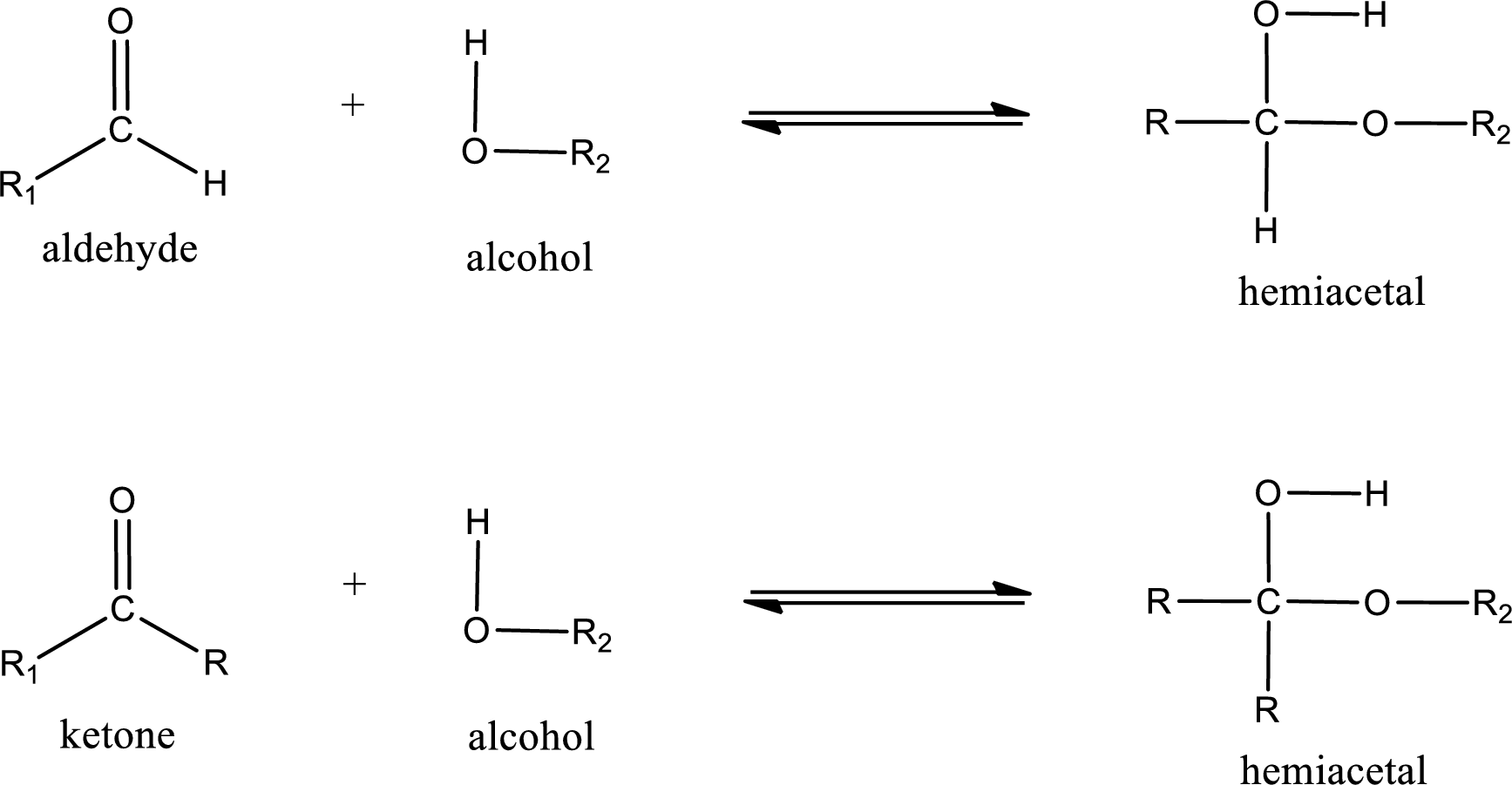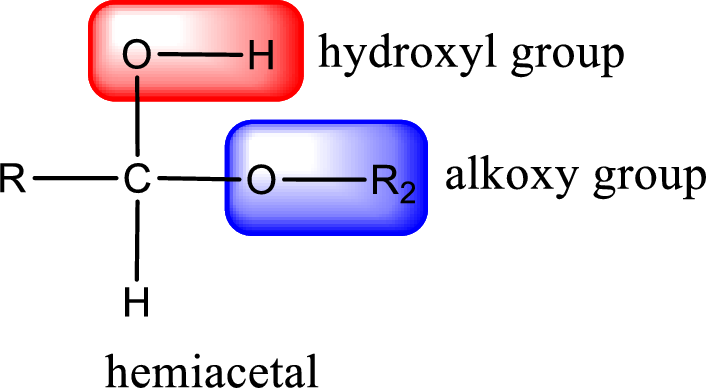
(a)
Interpretation:
Condensed structural formula of the organic product that is formed when pentanal is treated with hydrogen in presence of nickel catalyst has to be given.
Concept Introduction:
In
In organic chemistry, reduction reaction is referred to the number
Alcohols undergo oxidation reaction and reduction reaction. This depends upon the number of hydrogen atoms that is bonded to the alpha carbon atom. Primary and secondary alcohol undergoes oxidation reaction while tertiary alcohol does not undergo oxidation reaction. Primary alcohols undergo oxidation to give
Aldehyde undergoes oxidation to give carboxylic acid as the product while ketone does not undergo oxidation reaction.
The reverse of
(b)
Interpretation:
Condensed structural formula of the organic product that is formed when pentanal is treated with ethanol in 1 to 1 reacting ratio has to be given.
Concept Introduction:
Aldehydes contain a carbonyl group that is bonded to a hydrogen atom and a carbon atom. Ketones are compounds that contain a carbonyl group bonded to two carbon atoms. Aldehydes and ketones undergo addition reaction across the carbonyl group.
Aldehydes and ketones react with alcohol to form hemiacetal as the product. This reacts with further molecule of aldehyde or ketone to form acetal.
Hemiacetal is an addition product that is obtained by reaction between aldehyde or ketone with alcohol. The general reaction of hemiacetal formation can be given as,

(c)
Interpretation:
Condensed structural formula of the organic product that is formed when pentanal is treated with methanol in 1 to 2 reacting ratio has to be given.
Concept Introduction:
Aldehydes contain a carbonyl group that is bonded to a hydrogen atom and a carbon atom. Ketones are compounds that contain a carbonyl group bonded to two carbon atoms. Aldehydes and ketones undergo addition reaction across the carbonyl group.
Aldehydes and ketones react with alcohol to form hemiacetal as the product. This reacts with further molecule of aldehyde or ketone to form acetal.
Hemiacetal is an addition product that is obtained by reaction between aldehyde or ketone with alcohol. The general reaction of hemiacetal formation can be given as,

From the above general structure of hemiacetal it is found that it is an organic compound that contains a carbon atom that is bonded to an alkoxy group and a hydroxyl group.

Acetal is formed when the formed hemiacetal reacts with further alcohol molecule so that the hydroxyl group in the hemiacetal is converted into alkoxy group. This can be shown as given below,

The alcohol that is reacting with the hemiacetal can be from the same alcohol which involved in formation of hemiacetal or a different alcohol molecule. Therefore, the ketone or aldehyde must react with two alcohol molecules that may or may not be identical to form acetal.
(d)
Interpretation:
Condensed structural formula of the organic product that is formed when pentanal is treated with
Concept Introduction:
In organic chemistry, oxidation reaction is referred to the number
In organic chemistry, reduction reaction is referred to the number
Alcohols undergo oxidation reaction and reduction reaction. This depends upon the number of hydrogen atoms that is bonded to the alpha carbon atom. Primary and secondary alcohol undergoes oxidation reaction while tertiary alcohol does not undergo oxidation reaction. Primary alcohols undergo oxidation to give aldehyde and carboxylic acid as product. Secondary alcohol undergoes oxidation to give ketone as the product.
Aldehyde undergoes oxidation to give carboxylic acid as the product while ketone does not undergo oxidation reaction.
Trending nowThis is a popular solution!

Chapter 15 Solutions
Bundle: General, Organic, And Biological Chemistry, Loose-leaf Version, 7th + Lms Integrated For Owlv2 With Mindtap Reader, 4 Terms (24 Months) ... Chemistry (powered By Owlv2), 4 Terms (2
- C. Draw a structural formula for the principal organic product formed when each compound is treated with K2CrzOr/H2SO4 if there is no reaction, say so. 1. butanal 2. benzaldehyde 3. cyclohexanone 4. cyclohexanol 5. 2-pentanonearrow_forwardHydrolysis of the ester CH3-CH2-COO-CH2-CH2-CH3 in dilute acid, gives a. acetic acid and ethanol b. propanoic acid and ethanol c. propanoic acid and 1- propanol d. acetic acid and 1-propanolarrow_forwardGive the products formed when Benzaldehyde and Benzoic Acid are treated with the given reagents. a. Tollen’s reagentb. phenylhydrazine, H+c. HCNarrow_forward
- Draw the structure(s) of the major organic product(s) of the following reaction. 1. Dry Et₂O & + CH3Mgl H 2. aqueous HCI at 0°arrow_forwardWhich of the following statements is true? a. Both aldehydes and ketones are easily oxidized.b. Neither aldehydes nor ketones are easily oxidized.c. Aldehydes are easily oxidized, but ketones are not.d. Ketones are easily oxidized, but aldehydes are not. 2. Which of the following is obtained by oxidizing hexanal? a. hexanol b. 2-hexanone c. hexanoic acid d. none of these 3. Which of the following oxidizing agents oxidizes aldehydes in the body? a. NADH b. NAD+c. O2 d. none of these 4. Which of the following will be obtained by the reaction of pentanal with H2 in the presence of a transition metal catalyst? a. pentene b. 1-pentanolc. 2-pentanol d. pentanoic acid 5. The reaction of which combination of reactants result in the formation of a hemiacetal? a. ketone and alcohol b. ketone and aldehydec. ketone and carboxylic acid d. none of thesearrow_forward1. What is the role of the acetic acid in the oxidation of Cyclohexanol to Cyclohexanone? Write the balanced chemical reaction between acetic acid and sodium hypochlorite.2. How do you neutralize the acetic acid regenerated in the reaction? Write the balanced chemical reaction.arrow_forward
- 9. Assign an IUPAC name to each of the following compounds. 2. a. CH3-C-O-C-CH2-CH, b. CH3-CH2-CH-CH-C-CI L. C. CH3-CH-CH-C-Cl ČH3 CH3 d. CH3-CH-C-0-C-H Draw the structures of the esters formed by reacting the following substances 1 molecule methanol and 1 molecule phosphoric acid 2 molecules methanol and 1 molecule phosphoric acid 1 molecule methanol and 1 molecule nitric acid 1 molecule ethylene glycol and 2 molecules of nitric acid 0. A. В. C, D.arrow_forward45. Which of the following compounds has the lowest water solubility? a. butanal b. heptanal c. hexanal d. pentanal 48. Which of the following compounds is the most soluble in water? a. butanal b. heptanal c. hexanal d. pentanal 56. Which of the following compounds will undergo oxidation using potassium dichromate to form a carboxylic acid? A a. A and B only b. A and C only c. B only d. C only H B o Carrow_forward5. What products would result from the following processes? Write an equation for each reaction. a. 2-Methyl-2-butanol is subjected to controlled oxidation. b. 1-Propanol is heated to 140°C in the presence of sulfuric acid. c. 3-Pentanol is subjected to controlled oxidation. d. 3-Pentanol is heated to 180°C in the presence of sulfuric acid. e. 1-Hexanol is subjected to an excess of oxidizing agentarrow_forward
- II- Chemical Reactions of Aldehydes and Ketones. 1. Draw the structural formula of the organic product when each of the following aldehydes is oxidized to carboxylic acid. a) Ethanal b) Pentanal c) Formaldehydes d) 3,4-dichlorohexanal 2. What are the characteristics of a positive Tollens test for aldehydes? 3. What is the oxidizing agent in Tollens solution? 4. What are the characteristics of a positive Benedict's test for aldehydes? 5. What is the oxidizing agent in benedict's solution?arrow_forwardWhat is the systematic IUPAC name for the given compound? CH3 CH3 CH;CHCH,CH,CH2 -Ń-CH3 a. N-methyl-4-methylhexan-1-amine b. 2,4-dimethylhexan-1-amine c. 2,2,N-trimethylpentan-1-amine d. N,N,4-trimethylpentan-1-aminearrow_forwardDraw the structure(s) of the major organic product(s) of the following reaction. aqueous H,SO. KCNarrow_forward
 Chemistry for Today: General, Organic, and Bioche...ChemistryISBN:9781305960060Author:Spencer L. Seager, Michael R. Slabaugh, Maren S. HansenPublisher:Cengage Learning
Chemistry for Today: General, Organic, and Bioche...ChemistryISBN:9781305960060Author:Spencer L. Seager, Michael R. Slabaugh, Maren S. HansenPublisher:Cengage Learning
